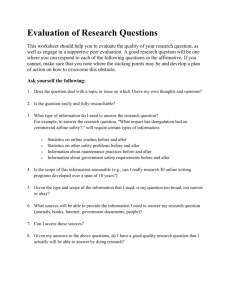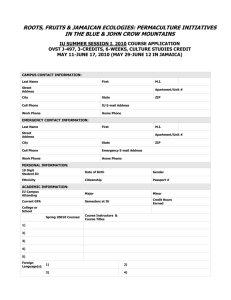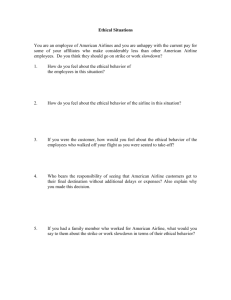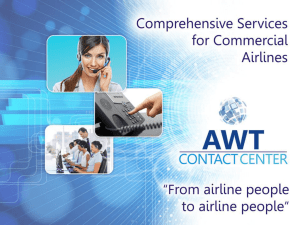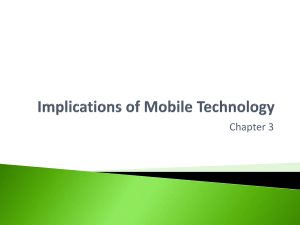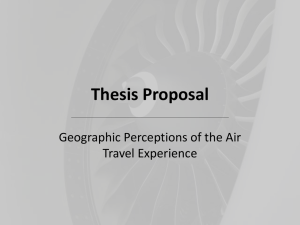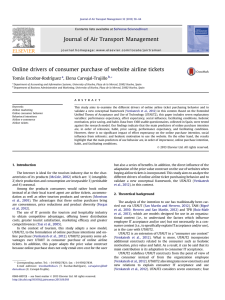Developing A Strategy For The Internet Age The Five Forces Model
advertisement
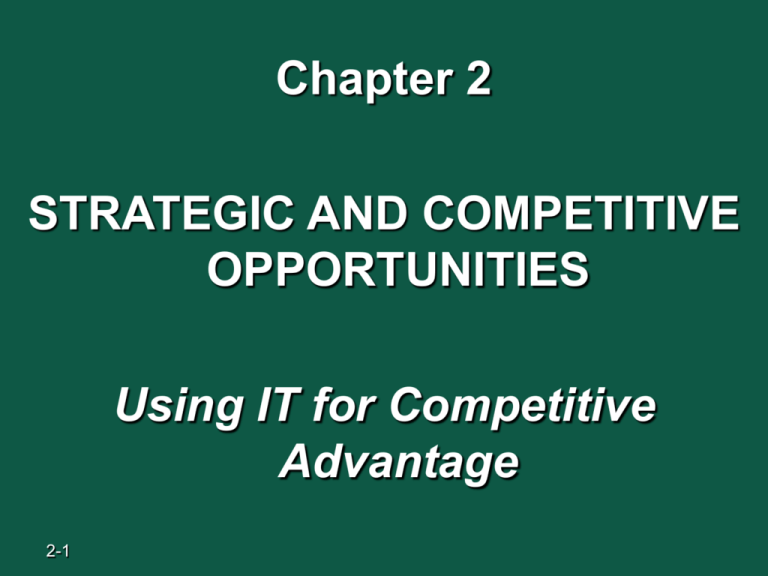
Chapter 2 STRATEGIC AND COMPETITIVE OPPORTUNITIES Using IT for Competitive Advantage 2-1 What’s up this week? 2-2 Read chapters 2 and XLM B for quiz 2 (posted on Tuesday) Take second quiz Read chapter 4 and XLM … for quiz 3 Take third quiz (posted on Thurs) Install SAM/TOM Try to make a chat session (see calendar for schedule of times) Get next Excel assignment for over the weekend Chapter Overview 2-3 Competitive Advantage Examples Developing A Strategy For The Internet Age Key E-Commerce Strategies The U.S. Airline Industry Opening Case Study Zara – Fashion Fast Forward Zara sets itself apart with its computerized network that ties stores to design shops and company-owned factories in real time. How can technology be used to respond quickly to shifts in consumer tastes? 2-4 Introduction Competitive advantage – a company provides a product or service in a way that customers value more than what the competition is able to do. Application architect - information technology professional who can design creative technology-based business solutions. 2-5 Competitive Advantage Examples Temporary advantage - whatever you do, sooner or later the competition duplicates what you’ve done. First mover - the company who is first to market with a new IT-based product or service. Distribution chain - the path followed from the originator of a product or service to the consumer. Alliance partner - a company you do business with on a regular basis in a cooperative fashion. 2-6 Competitive Advantage Examples Information partnership - lets two or more companies cooperate by integrating their IT systems. Business to Business (B2B) - companies whose customers are primarily other businesses. Business to Consumer (B2C) -companies whose customers are primarily individuals. 2-7 Competitive Advantage Examples Federal Express Charles Schwab Direct sell model Cisco Systems 2-8 Stock trades over the Internet Dell Computer Access information over the Internet On Your Own Direct sell model over the Internet Looking for Opportunities Close to Home Developing A Strategy For The Internet Age The Five Forces Model 2-9 Developing A Strategy For The Internet Age The Five Forces Model Five forces model - determines the relative attractiveness of an industry. Buyer power Supplier power Threat of substitute products or services • 2-10 Switching costs - costs that can make customers reluctant to switch to another product or service. Threat of new entrants Rivalry among existing competitors Developing A Strategy For The Internet Age The Three Generic Strategies Three generic strategies 2-11 Cost leadership Differentiation Focused strategy Developing A Strategy For The Internet Age Using the Five Forces Model Buyer power Supplier power Loyalty programs. B2B marketplace - an Internet-based service which brings together many buyers and sellers. Threat of substitute products or services 2-12 IT-based alternatives. Developing A Strategy For The Internet Age Using the Five Forces Model Threat of new entrants Entry barrier - a product or service feature that customers have come to expect from companies in a particular industry. Rivalry among existing competitors 2-13 Using IT systems to be more efficient. Developing A Strategy For The Internet Age Bridging the Gap Between Business People and Technical People Project team - a team designed to accomplish specific one-time goals which is disbanded once the project is complete. 2-14 Developing A Strategy For The Internet Age Using the Three Generic Strategies Use the three generic strategies to change the basis of competition. Amazon.com makes the buying experience a pleasure by using sophisticated software to personalize the site for each individual. 2-15 Developing A Strategy For The Internet Age Developing a Creative Design 2-16 Creative design solves the business problem in a new and highly effective way rather than the same way others have done it. Team Work Finding the Best IT Strategy For Your Industry (p. 83) Developing A Strategy For The Internet Age The Value Chain Business process - a standardized set of activities that accomplishes a specific task, such as processing a customer’s order. Value chain - views the organization as a chain – or series – of processes, each of which adds value to the product or service for the customer. 2-17 Developing A Strategy For The Internet Age The Value Chain 2-18 Developing A Strategy For The Internet Age The Value Chain Talbott used the value chain to: 2-19 Plan for a better way of meeting customer demands. Identifying processes that add value. Identifying processes that reduce value. Developing A Strategy For The Internet Age The Value Chain 2-20 Developing A Strategy For The Internet Age The Value Chain 2-21 Developing A Strategy For The Internet Age Looking Beyond The Four Walls Of The Company Just-in-time - an approach that produces or delivers a product or service just at the time the customer wants it. Supply chain - consists of the paths reaching out to all of a company’s suppliers of parts and services. Collaborative planning, forecasting, and replenishment (CPFR) - a concept that encourages and facilitates collaborative processes between members of a supply chain. 2-22 Key E-Commerce Strategies Mass Customization and Personalization Mass customization - a business gives its customers the opportunity to tailor its product or service to the customer’s specifications. Personalization - a Web site can know enough about your likes and dislikes that it can fashion offers that are more likely to appeal to you. Collaborative filtering - a method of placing you in an affinity group of people with the same characteristics. 2-23 Key E-Commerce Strategies Disintermediation Disintermediation – using the Internet as a delivery vehicle, intermediate players in a distribution channel can be bypassed. 2-24 Key E-Commerce Strategies Global Reach Global reach - the ability to extend reach to customers anywhere there is an Internet connection, and at a much lower cost. 2-25 The U.S. Airline Industry Airline Reservation Systems The airlines really began using IT in a significant way when American Airlines and United Airlines introduced the first airline reservations systems. 2-26 SABRE APPOLO The U.S. Airline Industry Frequent Flyer Programs Frequent flyer programs are a great example of using IT to alter Porter’s five forces. 2-27 They reduced buyer power by making it less likely a traveler would choose another airline. They reduced the threat of substitute products or services by increasing switching costs. They erected entry barriers by making a frequent flyer program a practical necessity for any airline to compete effectively. The U.S. Airline Industry Disintermediating the Travel Agent Expert surveys have estimated that the number of travel agents in the U.S. will be sharply reduced as a result of disintermediation. 2-28 Team Work Helping the Little Guy Compete (p. 93) The U.S. Airline Industry Utilizing Emerging Technologies Permission marketing - when you have given a merchant your permission to send you special offers. 2-29 Summing It Up On Your Own Building on the State of the Art (p. 95) 2-30 Closing Case Studies GM Tries to Lure Customers with OnStar Did the OnStar system give GM a competitive advantage? Speedpass: Throw Away Your Plastic? Speedpass is an alternative to a credit card. How is Speedpass an example of a first mover? 2-31 Hang in there! 2-32
